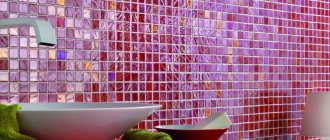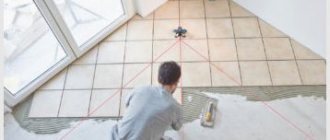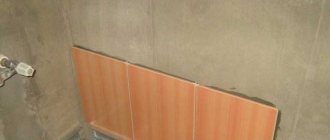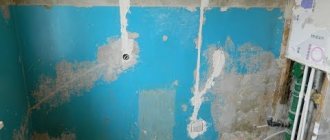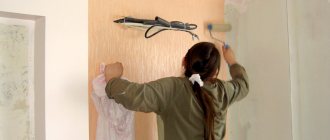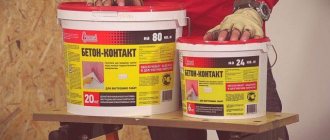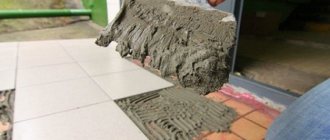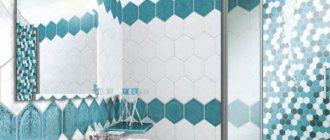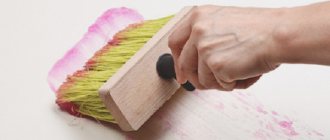How to glue mosaic tiles on a mesh - expert advice
The bathroom is the face of the whole house; guests inevitably end up there.
Therefore, it should look presentable. There are no trifles in this matter: the floor, ceiling, walls must be covered not only with practical, but also with beautiful material that is easy to maintain and maintain. As an option, along with large-sized ceramic tiles, builders began to use mosaic tiles. Traditionally, mosaic is considered a high-class material, and previously not many could afford to use it for renovation. The main difficulty was laying many small tiles, but now this problem has been solved. Mosaic on a mesh that combines individual particles into easy-to-install blocks allows you to attach the material quickly and without much effort. But before you go to the store, it’s worth learning more about the types of mosaic tiles, their purpose and the nuances of installation.
Mosaic tiles in the interior
Tools for laying mosaics
To lay mosaic tiles you will need the following materials and tools:
- styling adhesive;
- mosaic tiles;
- grout for seams;
- tape measure, pencil, building level;
- small grinder with speed controller + discs for stone/ceramics, pliers for cutting mosaics;
- container for mixing glue;
- drill mixer;
- serrated (corrugated) spatula with a tooth stroke of up to 5 mm;
- graters up to 30 centimeters;
- rubber spatula;
- regular spatula;
- water container + sponge with soft and rough sides;
- felt or flannelette rag.
How to make a mosaic kitchen apron with your own hands
In this article we will look at how to decorate a kitchen with a mosaic apron with your own hands. While this may seem complicated and time-consuming, the process is actually quite simple and quick.
The installation process consists of several stages: preparing the walls, marking, preparing and applying glue, laying the mosaic, cleaning, sanding and grouting.
To work you will need:
- mosaic;
- tile adhesive;
- large and medium spatulas;
- notched spatula;
- mallet;
- grout;
- rubber spatula;
- sponge.
For ease of grouting, we purchased a set of plastic or rubber spatulas. Instead of a mallet, a wooden block was used.
Applying adhesive to mosaic tiles
After treating the wall with glue, you need to coat the tile itself on the back side. It is best to carry out this procedure using a smooth, non-notched spatula. When laying mosaic tiles, you can use the double application method of adhesive. This method of applying adhesive is ideal for mosaic tiles. It is especially suitable for laying translucent or transparent mosaics.
If you glue such a tile onto a layer of adhesive already applied to the surface of the walls, then the adhesive strips from the notched trowel will not be visible through it.
What should be the surface for laying
On what surface can mosaics be glued? The facing material is small in size. Therefore, all unevenness of the base will be emphasized by the facing material. If this is what the designer intended, then you should choose adhesives with high adhesion rates and a short hardening time. The thickness of the mosaic adhesive is small in order to avoid “floating” the tiles. It is also important to take into account the fact that the seams should be left unfilled until the glue has completely dried.
When designing a plane, the surface must be pre-leveled. Mortars for laying mosaics may have filling ability without shrinkage, but leveling the mosaic with a large layer of glue will be inconvenient. It is worth noting that cheap materials lose the volume specified by the master during drying. This leads to the fact that the tiles will not give an even plane.
TOP manufacturers
- Axton mosaic adhesive. It is used for interior decoration with mosaics in bathrooms, showers, and kitchens. Axton glue is available in the form of a dry mixture for mixing. Has high adhesion to concrete, brick and plaster.
The diluted mixture is viable for 2 hours. Economical consumption, allows you to apply glue in a layer of up to 5 mm. Axton provides reliable fastening without loosening or falling out of mosaic chips.
You can adjust the position of the tile within 15 minutes. Complete curing and drying occurs within a day. A package of 5 kg costs from 125 rubles.
- LITOACRIL PLUS glue is a dispersion solution, accelerated curing in the form of a thick white paste. Suitable for use on plastic, wood, glass surfaces. It is resistant to slipping on vertical and smooth planes.
LITOACRIL PLUS can be applied in a layer of 2 mm. Withstands temperature changes from -30 to +90˚С. With rapid hardening, the adhesive has an increased open layer life. That is, adjustments are possible within 30 minutes. A package weighing 1 kg costs from 500 rubles.
- Tile adhesive PLITONIT C is a dry cement mixture for dilution with water. Suitable for indoor and outdoor use. It is used for tiles and mosaics of any size when installed on complex substrates: painted, on old tile coverings, in swimming pools, on the “Warm Floor” system.
Complete drying time - 24 hours, adjustments - 30 minutes. To level walls with defects, the height of the adhesive layer is allowed to be up to 10 mm. After mixing, the PLITONIT C mixture retains its qualities for 4 hours. Packaging 25 kg. costs from 650 rub.
Final processing
When installation is complete, clean the area from any remaining adhesive solutions and allow it to dry slightly. And then they begin the final processing of the area.
The following solution is used for grouting joints:
- Cement fugue. Based on Portland cement, which contains modifying components.
- Latex grout. The composition includes a latex particle to improve the characteristics of the solution.
Some types of mastic contain glitter; this solution is perfect for decorating glass mosaics.
Taking into account the rules of arrangement, you can easily create a special interior in the bathrooms by laying out the walls and floor in the pool.
Required Tools
The choice of tool depends on the thickness of the selected mosaic tile. Usually the standard list includes a spatula and a trowel for applying glue. Experts often use a notched trowel in their work. It allows you to distribute the glue in a more even layer, removing its excess. In addition, you will need a building level and a special tool so that you can later smooth the tiles.
For such equipment, you can take a regular roller.
Mosaic adhesive - dispersion, cement or reactive?
There are three types of compounds that can be used to glue tiles onto the mesh. They are given below:
- dispersive;
- cement (otherwise called dry);
- reactive (consisting of two components).
Cement tile adhesive
Dispersion adhesive is considered acceptable in cost and quite easy to use. It consists of one component. You do not need to stir the composition, add water or any other solvents to it. The glue is ready for use immediately after purchase from a hardware store. The undoubted advantage of dispersion compositions is that they do not lose their properties during storage. You can open the glue, use a certain amount of it, and then close the lid tightly and leave the jar until the next repair. Another advantage of working with such a composition is the absence of dust and dirt. Gluing tiles with a dispersion compound is a pleasure! But only on condition that the amount of finishing work is quite modest.
If you need to veneer not one small wall, but several large surfaces, it is better to use cement glue. It can be made on the basis of gray or white cement. Such compositions are elastic, rigid and deformable (with a very high level of elasticity). To install tiles on a clean and smooth plastered or brick wall, it is recommended to use rigid compounds. But elastic variations of glue are used for cladding complex surfaces. For example, those that are susceptible to temperature changes or vibrations.
Flexible adhesives are commonly used in kitchens and bathrooms. It is also indispensable for finishing uneven walls in other rooms. Elastic compounds are also used for surfaces made of foam and aerated concrete blocks. They can be used for installing mosaic tiles on a grid on a concrete screed. In terms of price, cement adhesive is cheaper than dispersion adhesive. But it must be mixed with water or latex immediately before use. This operation should be performed using a construction mixer. Naturally, when stirring the composition, you will not be able to avoid dirt and dust in the room. For this reason, few home craftsmen buy cement mixtures in order to glue mosaics themselves.
The most expensive is reactive glue. It consists of two components - a hardener and a base, which can be epoxy and polyurethane. It makes sense to purchase such a composition in cases where you plan to glue mosaic tiles to a wall made of natural stone, to a plastic, wooden, metal or glass surface. Before use, the adhesive components are mixed. They enter into a chemical reaction and in just a couple of minutes we get the finished composition.
It is necessary to use mixed reactive glue as quickly as possible. It dries out very quickly. And after hardening it becomes unsuitable for finishing work.
Glue selection
The quality of attachment of the material to the surface, as well as the final result of the work itself, depends on the correct choice of glue. When choosing an adhesive, you should consider the material from which the tiles are made. An important role is played by the thickness of the facing material and its transparency. You can choose a special glue, which is sold in every hardware store and is intended for all types of mosaics.
As a rule, this glue contains sand, which is why it has a gray tint. This type of glue is suitable if the material is opaque and is glued to a familiar surface (floor or wall). If the mosaic is transparent, it is better to pay attention to glue with a similar composition and white color.
This glue can be used during installation of glass material.
Epoxy glue is one of the more reliable. It can be used for cladding those surfaces that will be subject to frequent use. For example, this glue is often used for laying floors.
You can pay attention to the hard or deformable composition:
- The first option can be used for concrete or brick surfaces. As a rule, this glue is chosen for walls.
- Deformation will be needed if the house is subject to frequent vibrations (for example, if a railway passes nearby). This type is suitable for finishing surfaces that are subject to temperature changes.
Joining mosaics
The final stage of laying mosaic panels is jointing or applying a layer of grout. This is required to protect the space between the tiles from moisture, preventing the destruction of the bottom layer. It also creates an aesthetically pleasing finish to the decor. When applying the grout mixture, it is important to take into account the difference in cell depth between individual elements and entire sheets. Excess grout can be easily removed with soapy water.
Mosaic on a building mesh is a good option for quick, beautiful and durable repairs. See many design options on the TILES FROM FACTORY website. We also invite you to visit the comfortable Kerama Marazzi store in Moscow at Budyonny Ave., 27.
Sanding and grouting
Before grouting, excess glue must be removed. There are special brushes with metal bristles for this. Then prepare the grout according to the instructions.
It is important to correctly correlate the amount of water with the dry mixture. The grout should not be too thick or thin.
Apply the grout with a rubber spatula, distributing the mixture evenly along the seams.
The grout is difficult to clean off the mosaic, so carefully remove the excess with a spatula. It dries quickly, so if you are not confident in your abilities and cannot grout quickly, it is better to dilute it little by little. All minor mistakes when laying mosaics will be corrected by grouting. Having rubbed the seams, wait 15-30 minutes.
Then use a sponge soaked in clean water to remove all excess.
We used white grout, and in our case it almost merged with the mosaic, and it turned out not very impressive.
It would be better to use grout in contrasting colors to grout the seams of a mosaic kitchen apron.
Cladding stages
The use of mosaic tiles is quite common: they are used both for finishing a room and for decorating individual elements. In this case, the tiles can be laid on the floor, on the wall, on the ceiling, on the windowsill and on the countertop.
The technology of laying mosaics is not very different from laying tiles, but requires more responsibility. A convenient point when gluing mosaic tiles is their flexibility, which allows you to stretch or narrow the seams.
Glass mosaic is most often used for swimming pools, although it can also be found quite often on walls and floors as panels. The installation of glass mosaics should be planned taking into account lighting, because... horizontal backlight will display all errors.
Tools required for installation:
- 2 spatulas (smooth and serrated edge);
- roller or rubber grater;
- building level;
- knife;
- pencil and ruler.
To lay tiles on the floor, it is better to use a more durable material: stone, marble or porcelain stoneware. Laying marble mosaics is an ideal option for a bathroom interior. This is the most durable material used for flooring. In this case, it is necessary to monitor the color of the selected glue: it should be white, not gray. This is due to the fact that marble quickly absorbs everything and changes its color shade forever.
When arranging a kitchen, bathhouse, or cafe, wooden mosaic cladding is used. This option has a lot of positive properties: strength, soundproofing, durability and uniqueness.
Preparing the foundation
Mosaic tiles should only be laid on a prepared base. After removing the remnants of wallpaper, paint and other coatings, you need to check the plaster. A prerequisite when preparing to lay tiles is to apply a primer to hide traces of dust and improve adhesive properties. After priming and checking the walls using a level, you can proceed to the next stage.
We carry out the markings
After the primer has completely dried, the surface is marked. First of all, you need to decide how the mosaic will be laid. The choice will depend on your imagination and preferences. In addition to the classic one, there are other options for laying out mosaic tiles:
- alternating matte and glossy types;
- combining mosaics with tiles;
- pixel mosaic;
- panels and paintings;
- use of hexagonal mosaic.
The location of the mosaic pieces must be carefully marked. When drawing up a sketch, pay attention to the following points:
- if there are slopes and boxes in the room, the drawing begins to be laid out from them;
- if there is a decorative element in the room, then it is a priority;
- Try to hide all possible undercuts in a corner or at the bottom of the floor.
After the sketch is drawn up, it is transferred to the wall.
Apply glue
Gluing mosaic tiles is not difficult, but you need to choose the right glue. When choosing an adhesive composition, the surface material on which the tiles are laid matters. To prevent the appearance of an unwanted shade, it is better to choose white glue for glass mosaics.
As for the preparation of the glue, the solution is prepared in accordance with the requirements specified on the packaging. After studying the instructions, apply the glue to the surface using a rubber spatula.
It is undesirable to apply glue directly to a surface with a large area, because... it dries quickly and forms a film on the wall. It is better to dilute the amount of glue that will be used immediately.
Laying on floors and walls
Laying mosaics with your own hands should begin with those places that catch your eye the most. Unlike the technology for laying ceramic tiles, in this case there is no need for additional support - if the work is done evenly, the mosaic will not slip or fall off. Given the high flexibility of the material, you should not press it with your hands - because of this, the sheets may lie unevenly. The optimal tool in this case would be a silicone roller.
Laying mosaic tiles on a grid:
- In this embodiment, the sheet is turned with its front side towards itself, and its back side is completely immersed in the glue.
- The sheet is gently pressed with a rubber spatula.
- The distance between the mosaic pieces is checked (it should be the same).
- The remaining adhesive is removed from the tiles, which are left to dry completely.
Laying on paper base:
- Turning the sheet of paper with the paper side towards you, glue it to the wall and tap it with a spatula to distribute it evenly.
- After laying the second line, we return to the first and blot the paper with a damp sponge until it begins to easily peel away from the surface. Remove paper from the mosaic from the top corner, getting as close to the surface as possible.
- After removing the paper backing, the seams and tiles are leveled with a small spatula.
- Before applying grout, the tiles are left to dry for 24 hours.
We produce grout
Grouting is carried out only after the solution has completely dried, and for this a minimum of 2 days must pass. The facing surface is cleaned with a brush and warm water. If there are smudges of glue at the joints, remove any remaining glue with a knife or sharp blade.
The mixture is diluted according to the instructions and applied at an angle of 45°. The grout is left to dry for 20 minutes, after which it is cleaned with a dry cloth to remove any remaining mixture. It is then washed with water and polished after drying.
Mapei grout is a win-win option from the Italian manufacturer. Its only disadvantage is that it quickly sets to the surface.
Features of the material and its varieties
Mosaics are small (1x1 cm) fragments of finishing materials, located at regular intervals and forming a single picture. In the case under consideration, these elements are fixed on a flexible metal mesh. This material can be used for cladding floors and walls, as a covering for kitchen furniture, and even for decorating facades and garden paths.
According to the type of surface, mosaic can be glossy or matte. Gloss is easier to maintain and is more often used for walls in rooms with high humidity (bathroom, kitchen), while matte tiles, which have anti-slip properties, are more suitable for flooring.
Another criterion that affects the appearance, technical characteristics and cost of the mosaic is the material of manufacture. On sale are mosaics from:
- Ceramics. These tiles differ from standard ceramic tiles only in size. It comes in different textures and colors and can imitate other materials. The main advantages are affordability and ease of care.
- Glass. Glass mosaic laid on the floor
Glass mosaic
in a shower stall or swimming pool creates an indescribable play of glare. It is quite durable, thanks to the smalt it contains, and has a wide color palette. Resistance to moisture and temperature changes makes it ideal for bathrooms. It is also resistant to fungus and is easy to care for even in damp areas. Disadvantages: high cost and limitations in the choice of glue and grout. - Natural stone. Stone mosaics are made from jasper, marble, sandstone, etc. A coating made of such material looks impressive on garden paths, walls, floors and the facade of a building and always turns out to be unique, because in nature there are no identical stones. But the high price often scares away buyers.
- Concrete. Mosaic tiles, made from concrete and marble chips, are more often used for outdoor work. It can withstand high loads and is suitable for use in harsh climates.
- Metal. The manufacturing material for this tile is stainless steel. Due to its spectacular appearance and increased wear resistance, the installation of such mosaics in the bathroom, as well as covering floor surfaces with it, has recently become increasingly popular.
